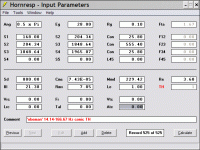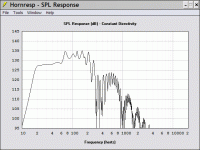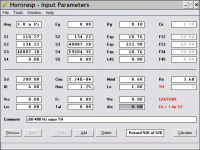Hello,
as i worked in a disco, all the 15 amps are
open level control at "11 a clock" this is
only 5 W impuls, most Hifi speaker didn´t
get that because the Xmax is an listenable end,
so the max Watt are not so important, may be for open air PA.
so better don´t turn the level control over "12 a clock".
as i worked in a disco, all the 15 amps are
open level control at "11 a clock" this is
only 5 W impuls, most Hifi speaker didn´t
get that because the Xmax is an listenable end,
so the max Watt are not so important, may be for open air PA.
so better don´t turn the level control over "12 a clock".
Hi guys!
would this work alright in tapped horn?
sd around 760-800cm^2
fs 37.5 Hz
vas 67.8 L
qts 0.43
qes 0.45
qms 7.28
xmax/xmech 17/34 mm
re 3.6 ohm
mms 277 g
bl 22.6 TM
cannot use hornresp where i am.. driver selling with very nice price and somebody's gonna buy it soon..
would this work alright in tapped horn?
sd around 760-800cm^2
fs 37.5 Hz
vas 67.8 L
qts 0.43
qes 0.45
qms 7.28
xmax/xmech 17/34 mm
re 3.6 ohm
mms 277 g
bl 22.6 TM
cannot use hornresp where i am.. driver selling with very nice price and somebody's gonna buy it soon..
well when im trying to get it up to max volume, i have the volume control up full on the amp, my pc volume up 3/4 and apply upto 12db boast to the signal with my equalizer, im sure its the setup, will try my other amp in 180w bridged mono, im guessing maybe its just 2 old, i lost my job but when im back working i will try get a new amp and the crossover/preamp mentioned before
the signal before equalization is split between my other 2 amps and 4 mains, and 12" old woofers now crossed at 90hz upto 200hz, whole lot works fine
i found a program that for now works fine as a crossover on my pc if anyone is interested, basically i send 75hz and below to the sub 24db/octave Chebyshev, and 90hz and above to my mains (gets rid of that 80hz peak in my room, and sounds much better
it used different sound card channels/sockets for the different output bands, unto 4 i think, and its so amazingly simple and effective i wish it wasn't a plug in for a media player, but a sound card program, that would be amazing
thanks
the signal before equalization is split between my other 2 amps and 4 mains, and 12" old woofers now crossed at 90hz upto 200hz, whole lot works fine
i found a program that for now works fine as a crossover on my pc if anyone is interested, basically i send 75hz and below to the sub 24db/octave Chebyshev, and 90hz and above to my mains (gets rid of that 80hz peak in my room, and sounds much better
it used different sound card channels/sockets for the different output bands, unto 4 i think, and its so amazingly simple and effective i wish it wasn't a plug in for a media player, but a sound card program, that would be amazing
thanks
obeman said:Hi guys!
would this work alright in tapped horn?
sd around 760-800cm^2
fs 37.5 Hz
vas 67.8 L
qts 0.43
qes 0.45
qms 7.28
xmax/xmech 17/34 mm
re 3.6 ohm
mms 277 g
bl 22.6 TM
cannot use hornresp where i am.. driver selling with very nice price and somebody's gonna buy it soon..
will try and simulate it for u, but with a fs of 40hz your looking at a 20hz tuning, and its a big driver so it will be a big old horn
as im so bad will try sim in volvos 15" horn
i disagree with the below comment, loads of people use drivers with a large mass, even danley
obeman
Hello,
The inertia of membrane mass slows the music signal,
the smaller the volume level,
in living room areas usual,
the pronounced damped the moving mass of the diaphragm
signal playback, the main reason for the lack of serious bass
resolution of heavy weight bass membranes.
too much 277 gr
for a horn fs/qts should be over 120, normally,
FE206 has 216,66
Manger ~ 108
your 87,2
Hello,
The inertia of membrane mass slows the music signal,
the smaller the volume level,
in living room areas usual,
the pronounced damped the moving mass of the diaphragm
signal playback, the main reason for the lack of serious bass
resolution of heavy weight bass membranes.
too much 277 gr
for a horn fs/qts should be over 120, normally,
FE206 has 216,66
Manger ~ 108
your 87,2
yep, it has lots of mass, but nice strong motor also.
last version of that driver (mk3, that's mk4..have couple of mk3s laying around) had given fs of 33hz, but after some years of use, it was at 20 least according to my measurements of current draw vs voltage when free air..
least according to my measurements of current draw vs voltage when free air..
dunno what it was when brand new, but now suspension is much
more loose.
i find this funny, since people that have bought new ones have complained about Fs being much higher than the one given by manufacturer because of stiff suspension.. wonder if this is a global phenomena with subs - cms rising --> Fs lowering considerably during use.
so, i'm not all that confident with cms and fs values, and whatever higher cms does to others...
last version of that driver (mk3, that's mk4..have couple of mk3s laying around) had given fs of 33hz, but after some years of use, it was at 20
 least according to my measurements of current draw vs voltage when free air..
least according to my measurements of current draw vs voltage when free air..dunno what it was when brand new, but now suspension is much
more loose.
i find this funny, since people that have bought new ones have complained about Fs being much higher than the one given by manufacturer because of stiff suspension.. wonder if this is a global phenomena with subs - cms rising --> Fs lowering considerably during use.
so, i'm not all that confident with cms and fs values, and whatever higher cms does to others...
obeman said:Hi guys!
would this work alright in tapped horn?
Greets!
What brand/model for my records? Anyway, looks good in Hornresp up to ~196 W/16 Hz in a corner, though not tiny at ~548 L net:
GM
Attachments
for a horn fs/qts should be over 120, normally
Thats the word, normally. The tapped horn is a different beast that has different needs for a suitable driver. Read Danleys white paper.
Personally, I use two ratios as a part of my guidelines, Mms/Bl and Bl/Mms. Guidelines are however not the final word, there are many a driver that is far from what one would think be a good fit, that simulate very well in Hornresp, Soundsplinter RL-p15 is one for example.
cowanaudio said:You can't just buy Danley or Geddes speakers here! Freight would cost 1/2 as much as the speakers.
Gday William!
Remember corresponding to you in a post regarding JBL 2242H and 18sound 18LW1400 drivers. Well actually I have taken the tapped horn route, but non-DIY with the TH-112.
For those interested in DSL products maybe can contact Kelvin at www.thesoundbroker.com
He still can't give you a lot of discounts as apparently DSL now is recognised (or marketed/placed) as a premium brand in SR circles.
But I got quite a good deal in shipping (Bax Global/Schenker), I'm not sure if its good to post here but its definitely way below usd500. Our countries aren't that far away neither.
Thanks GM, nice work, had a hunch you'd show up with something. that had actually been "small" enought to be built. driver was spl dynamics 15d2 mk4 (in series)
http://www.spldynamics.fi/oldmodels/oldsubs/index-e.htm
had, because chose not to buy the driver - and off it went a day ago.
too different to join these couple mk3s in foreplanned large "infratuned" refl box. wan't 2 more of those for that.. so.. tapped horn was only choise of use, and yep.. that parameter difference.. anyway, good to know driver with those parameters would give results with the design..
refl box. wan't 2 more of those for that.. so.. tapped horn was only choise of use, and yep.. that parameter difference.. anyway, good to know driver with those parameters would give results with the design..
is there some formula for calculating mmd -as there seems to be quite a bit difference?
well, onto something that might actually be finished some day..
these 2 eminence govern(at)or.. 12" ohm driver:
http://www.eminence.com/guitar_speaker_detail.asp?model=THEGOVERNOR&speaker_size=12&SUB_CAT_ID=4
the plan is to test (and use if got lucky) these is one box, with drivers in V position, sharing the upwards opening first half of the horn after which both having their own, but same sized last part that ends behind and below them again in shared space and opening..
i managed to simulate really nice 50 to 400 hz extension, tho i'm dying to again remember what exactly were lenghts and areas..
is it safe to assume 2 drivers with good enought match were to
work well with shared first horn part?
and that response could be simulated with "one half"?
somehow can't seem to get 2 drivers look similar to just one :/
-Samuli
http://www.spldynamics.fi/oldmodels/oldsubs/index-e.htm
had, because chose not to buy the driver - and off it went a day ago.
too different to join these couple mk3s in foreplanned large "infratuned"
is there some formula for calculating mmd -as there seems to be quite a bit difference?
well, onto something that might actually be finished some day..
these 2 eminence govern(at)or.. 12" ohm driver:
http://www.eminence.com/guitar_speaker_detail.asp?model=THEGOVERNOR&speaker_size=12&SUB_CAT_ID=4
the plan is to test (and use if got lucky) these is one box, with drivers in V position, sharing the upwards opening first half of the horn after which both having their own, but same sized last part that ends behind and below them again in shared space and opening..
i managed to simulate really nice 50 to 400 hz extension, tho i'm dying to again remember what exactly were lenghts and areas..
is it safe to assume 2 drivers with good enought match were to
work well with shared first horn part?
and that response could be simulated with "one half"?
somehow can't seem to get 2 drivers look similar to just one :/
-Samuli
try the eminence definimax, what u are looking at is a guitar speaker, it only has a 1.2mm xmax so im guessing a single definimax would be louder as it has a 6.2mm xmax and costs less, also this saves the complexity of the V design, in my opinion it seems logical anyway
2 very nice horns have been made with this driver, mikehunts 30hz version and my own lower tuned 25hz/5db@20hz version, and im very happy with it
however u seem to be looking for a higher extension and higher cutoff so the xmax may not be an issue and u may need the higher resonance frequency
i thought a flat response from 50hz-400hz was only possible with a front loaded horn, in which case your in the wrong thread
2 very nice horns have been made with this driver, mikehunts 30hz version and my own lower tuned 25hz/5db@20hz version, and im very happy with it
however u seem to be looking for a higher extension and higher cutoff so the xmax may not be an issue and u may need the higher resonance frequency
i thought a flat response from 50hz-400hz was only possible with a front loaded horn, in which case your in the wrong thread
obeman said:Thanks GM, nice work..........
is there some formula for calculating mmd -as there seems to be quite a bit difference?
is it safe to assume 2 drivers with good enought match were to
work well with shared first horn part?
and that response could be simulated with "one half"?
You're welcome! Thanks!
Mmd is Mms minus the air load, but I don't know the formula. Since all the formulas I've seen use Mms, I don't understand why Hornresp uses Mmd.
Drivers sharing the same throat in a horn tend to average out somewhat due to the air mass loading, ergo in a tapped horn this would apply on both sides of the driver.
Why would you sim with 'one half' when you can sim two drivers? Anyway, ideally you'd measure both drivers and design based on their averaged specs, so don't understand why you're having problems simming two theoretically identical drivers.
GM
Naudio said:
i thought a flat response from 50hz-400hz was only possible with a front loaded horn, in which case your in the wrong thread
Not in theory. Consider this theoretical single 8" driver expo TH in half space coupled to an 8 W SET amp. It's no larger than some similar BW multiple 15" driver built in concrete horns I've seen pics of, so you can't say its size is untenable per se...........
GM
Attachments
GM said:I don't understand why Hornresp uses Mmd.
Hi GM,
Hornresp uses Mmd because dynamic mechanical mass is a fundamental parameter of the driver, whereas Mms is a derived value. The air load on the diaphragm is calculated internally by the program as necessary. Mmd can be determined using the 'Calculate Parameter' tool if Sd, Cms and fs are known.
Kind regards,
David
ah, of course. seems i did simulate with too large mmd, as guestimated air load to only couple of grams.Mmd can be determined using the 'Calculate Parameter' tool
sure is better, but reason for this project to actually finish some day is that i already have these laying around, for a year now..try the eminence definimax
it seems this design doesn't need lot of excursion (apart those "impulses".. first periods of waves that i'm not so sure of..)
definimax is bit expensive where i can easily get it, and neo kappalite cheaper
plus, i need that high frequency extension because these will
form the bass part for zomax horns http://www.ljudia.se/pdf/211335.pdf that go no lower that 200-300hz.
gonna mate these with eminence apt-50 tweeters. have this funky idea.. kind of coaxial horn of putting tweeter right in front of mid, forming a tight throat of a ring shape with it's magnet, structure and horn itself.
this for getting highfreq cancellation as low as possible + high xover possible.
Drivers sharing the same throat in a horn tend to average out somewhat due to the air mass loading, ergo in a tapped horn this would apply on both sides of the driver.
well, i'm kind of noob what comes to horns so... do i correctly assume that doupling driver surface (2 drivers) means doubling areas everywhere? might be wrong as i don't seem to get the frequencies match when simulating two.. this was the reason for simulating one half at a time.
with this.. 2 drives in V -shape -idea, i hope to smooth the high.
David McBean said:
Hornresp uses Mmd because dynamic mechanical mass is a fundamental parameter of the driver, whereas Mms is a derived value. The air load on the diaphragm is calculated internally by the program as necessary.
Mmd can be determined using the 'Calculate Parameter' tool if Sd, Cms and fs are known.
Greets!
OK, true, but it's normally derived also since it's very rarely published, so still not sure why you prefer it over the ~universally used Mms.
Understood, thanks, but I was hoping you'd publish the formula. Oh well, doing a bit of Googling yielded this from Bill Geiger:
[Mmd] = [Mms]-2*([Sd]^2)*[Ma1]
[Ma1] = 8*[p0]/(3*[pi]^2*[a]) - Acoustic Mass of Air Load on one side of equivalent piston (kg/m^4)
[p0] = 1.18 kg/m^3 - Air Density
[pi] = 3.14159
[a] - Driver Effective Radiating Piston Radius (m)
[Sd] = [pi]*[a]^2 - Driver Effective Radiating Area (m^2)
GM
obeman said:
........do i correctly assume that doupling driver surface (2 drivers) means doubling areas everywhere?
No, Sd has no bearing on speaker/horn design per se. Doubling drivers means doubling all dims of the horn due to a doubling of Vas to theoretically clone the single driver design, though wiring them in series will sum Le and halve it if wired in parallel, so there will be some performance variation from the single driver design that may require either adding a zobel filter or inductor.
GM
- Home
- Loudspeakers
- Subwoofers
- Collaborative Tapped horn project



